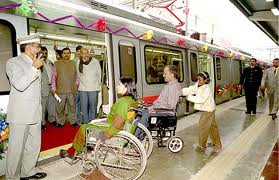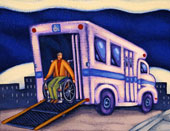Transport
Dial Metro station for help
Delhi Metro stations are providing special assistance to the differently-abled passengers. People with physical challenges can now dial 011-155370 in order to have an assistant at the entrance of the station.These assistant will meet the passenger at the entrance and then he would escort them right up to the train. There would be another person who would be ready at the destination or where the person has to get down to help them out.
The Metro helpline number can be used by passengers for other assistance also. Wheelchairs and stretchers are also available at the control rooms at the stations.The differently abled now don't have to go elevators used by general passengers. There are special elevators for differently-abled passengers.There is an allotted space in the first coach of each train where wheelchair passengers can travel comfortably. It would be better of the people with special needs inform the Metro station in advance about the assistance required by them by calling them so the proper arrangements can be made.
Delhi Metro
The facilities on the metro system are not only modern and aesthetic, but are also easily accessible for disabled commuters, including elderly people. It is probably the only agency involved with transportation in India that has incorporated accessible design in its facilities.
The new accessible New Delhi Metro Rail Corporation (D.M.R.C.) is ready for use by disabled people and seniors. It is probably the only agency involved with transportation in India that has thought of constructing an overhead ramp for the physically challenged. The ill and the disabled persons who cannot use the foot over bridges or subway, can now take the ramp from St Stephen's side at Tis Hazari station, and directly reach the concourse or ticketing area, which is on the second level of the station.
The facilities on the metro system are designed to be modern, aesthetic, and easily accessible for the disabled commuters. There are escalators and accessible elevators at all stations. In addition, the entry path is lined with tactile tiles to guide the visually impaired from outside the stations to the trains. Disabled commuters can also expect accessible seating on the trains, as well as Braille instruction signs and audio announcements.
The Metro Sahayaks (or Metro Helpers) are present at stations to provide assistance at all times. Some specific facilities for disabled commuters are:
Labels printed in braille in the lifts to indicate floors
Elevator control buttons positioned at heights that are accessible to wheelchair users
Grip rails on the the sidewalls of the elevator car
Wide doors for lifts
Ramps at the entrance of every station
Adequate landing space at the start and end of every ramp
Reservation for employment of physically challenged
Accessible toilets on every floor
Handrails inside toilets
Well lit corridors for persons with visual impairments
Ticket gate exclusively for disabled passengers
Tactile tiles on all common passages
Tactile warnings for abrupt change in height or near hazardous areas
Audible warnings and announcing devices wherever possible
The metro is now offering tours to better acquaint users with the new system. To do so, disabled users can go to the Kashmiri Gate station (West End) near Mori Gate Bus Terminal at 10 a.m. on any Wednesday for an orientation.
Railways
Railways allow disabled persons to travel at concession fares up to 75% in the first and second classes. Escorts accompanying blind, orthopedically and mentally handicapped persons are also eligible to 75% concession in the basic fare. A deaf and dumb person traveling alone (both afflictions together in the same person) on production of a certificate from a government doctor is eligible for the concession.A deaf person is allowed 50% concession in railway fare both in first and second class, but concession is not available for the escort. A deaf & dumb person is permitted to travel by 2-tier A.C. on payment of concessional fare for first class and full surcharge for 2-tier A.C. Sleeper.
Indian Railways Concession Certificate for Deaf and Dumb can be downloaded from the following link
http://www.indianrail.gov.in/CONCERTIFICATE147.pdf
Indian Railways Concession Certificate for Orthopedicallly handicapped can be downloaded from the following link
http://www.trainenquiry.com/StaticContent/Consession_Handicapped.aspx
Indian Railways Concession Certificate for Blind can be downloaded from the following link
http://www.trainenquiry.com/StaticContent/Consession_Blind.aspx
Indian Railways Concession Certificate for Blind can be downloaded from the following link
http://www.trainenquiry.com/StaticContent/Consession_MentalyRetarded.aspx
Air
The Indian Airlines Corporation allows 50% concessional fare to Blind persons or single journey or single fare for round trip journey on all domestic flights. To avail this facility (for blind persons) they have to product a certificate from a medical practitioner. Air Hostess/Steward will look after the Blind Persons not accompanied by escorts in flight. 50 percent concession fare on single journey or single fare for round trip journey is given to the blind people by the INDIAN AIRLINES CORPORATION.
Locomotor Disabled persons (80% and above) are allowed following Concession in Indian Airlines :
1. 50% of normal Economy Class INR Fare or Point to Point Fare, Full Inland Air Travel Tax and Passenger Service Fee applicable. 2. 50% of INR fare applicable to foreigners resident in India for travel on Domestic Sectors.
Bus
The Delhi government intends to run 11,000 buses in Delhi by 2011, of which 4,400 buses would run by private bus operators on more than 600 routes divided into 17 bus clusters. The doors will be automatic and will permit wheelchairs to be rolled in and out.The DTC has started introducing air-conditioned buses and brand new low-floor buses (with floor height of 400 mm (15.75 in) and even higher on one third area as against 230 mm (9.06 in) available internationally) on city streets to replace the conventional buses.Many such buses are already on road in Chandigarh and Mumbai.





